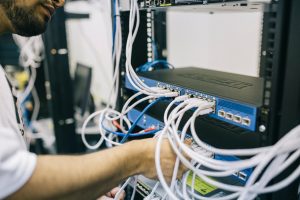How TSMC Became the Global Semiconductor Manufacturing Center
In 1987, few outside of Taiwan had heard of TSMC. Fast-forward to 2025, and the Taiwan Semiconductor Manufacturing Company is the undisputed titan of global chip production—its clients range from Apple and Nvidia to AMD and Qualcomm. But how did this formerly obscure contract chipmaker rise to control over 60% of global foundry revenue and become the bedrock of modern technology?
The Foundry Model That Changed Everything
TSMC’s rise begins with a radical idea: specialize in manufacturing chips for others. While giants like Intel clung to the integrated device manufacturer (IDM) model—designing and producing their own chips—TSMC’s founder, Morris Chang, placed a bet on pure-play foundry services. This separation allowed fabless design houses like Broadcom and MediaTek to focus purely on innovation without needing billions in fabrication facilities.
That model now dominates. As of 2025, nearly all cutting-edge 3nm and 2nm chips—powering everything from iPhones to AI data centers—are produced by TSMC. Intel, once dismissive of outsourcing, now relies on TSMC to produce several of its next-gen processors.
Investment in Leading-Edge Nodes
Where TSMC really pulled ahead was in pushing the limits of semiconductor physics. In the past five years alone, TSMC has invested over $100 billion into R&D and fab expansion, with major facilities in Taiwan, the U.S. (Arizona), and Japan.
| Node Size (nm) | Year Introduced | Key Customers | Performance Gain |
|---|---|---|---|
| 7nm | 2018 | AMD, Apple | ~35% over 10nm |
| 5nm | 2020 | Apple, Qualcomm | ~20% over 7nm |
| 3nm | 2022 | Apple, Nvidia | ~15% over 5nm |
| 2nm | 2024 (beta prod) | Nvidia, AMD, Intel | ~10–15% over 3nm |
As of Q2 2025, TSMC’s 2nm N2P node has entered volume production, with Apple’s A19 Pro and Nvidia’s Blackwell Ultra AI chips leading the charge.
Strategic Geographic Expansion
To hedge against geopolitical risks, especially rising tensions across the Taiwan Strait, TSMC has aggressively expanded production outside its home base. Its Arizona fabs (N4 and N3E) are on track for full capacity by late 2025, with EUV machines from ASML humming 24/7. In Japan, a joint venture with Sony ensures regional redundancy.
Despite expansion, Taiwan remains the crown jewel. Roughly 85% of TSMC’s cutting-edge production still happens in Hsinchu and Tainan, thanks to highly skilled engineers and tightly integrated local supply chains.
TSMC vs. Intel and Samsung: A 2025 Snapshot
| Metric | TSMC | Intel | Samsung Foundry |
|---|---|---|---|
| Market Share (Foundry) | ~59% | ~11% | ~13% |
| Latest Node in Production | 2nm (N2P) | 3nm (Intel 3) | 3nm GAA |
| Fab Locations | TW, US, JP | US, IL, DE | KR, US |
| Key Clients | Apple, Nvidia | Internal + AWS | Google, Qualcomm |
| Business Model | Pure-Play Foundry | IDM + Foundry | IDM + Foundry |
Intel’s turnaround under Pat Gelsinger and Samsung’s GAA process are notable threats, but TSMC’s consistent yield advantage and client trust remain unmatched.
The Role in the AI Revolution
TSMC is not just a passive chip fabricator—it is central to the global AI arms race. Nvidia’s latest H200 and B100 AI accelerators, as well as AMD’s MI400 series, are all built using TSMC’s custom HPC processes.
TSMC’s CoWoS (Chip-on-Wafer-on-Substrate) and SoIC (System-on-Integrated-Chips) packaging technologies have become essential for stacking HBM3e memory with logic chips, critical in high-performance AI workloads.
In fact, over 90% of global AI inference chips in 2025 are touched by TSMC’s fabs—whether directly or through packaging and advanced test services.
Challenges Ahead: Geopolitics, Yield, and Capacity
Despite its dominance, TSMC’s future isn’t risk-free. U.S.–China tensions continue to pose existential threats to Taiwan’s stability. Water shortages, power disruptions, and talent scarcity also weigh on local production reliability.
Additionally, competition is heating up. Samsung’s 2nm GAA process is gaining traction, and Intel Foundry Services has scored design wins from Microsoft and Amazon for future AI chips.
Yet, TSMC’s lead in process maturity, yield rates (~95% at 3nm), and customer trust makes it a fortress in 2025. So far, clients aren’t just sticking with TSMC—they’re doubling down.
FAQs
Q: Why does everyone rely on TSMC instead of making their own chips?
A: TSMC’s economies of scale, process maturity, and leading-edge capabilities mean it can produce chips at higher yield and lower cost than most companies can internally. It also lets chip designers focus on innovation without managing fabrication complexity.
Q: Can the U.S. or Europe catch up to Taiwan’s semiconductor dominance?
A: Not in the short term. While CHIPS Act investments in the U.S. and EU are ramping up, it will take years to match TSMC’s ecosystem, engineering depth, and supplier networks.
Q: Is TSMC’s dominance sustainable beyond 2030?
A: If it maintains leadership at the most advanced nodes (2nm, 1.4nm), invests in packaging innovation, and manages geopolitical risk, its dominance could extend well into the next decade.
You Might Like
- How Samsung Electronics Rose from Home Appliances to Global Tech Leader
- How Nvidia Built Its Chip Empire: From GPU to AI Revolution
If this breakdown helped you better understand how TSMC became the global semiconductor manufacturing center, share it with a friend or colleague. Got a thought or prediction about the chip industry? Drop it in the comments below—we’re always reading.



